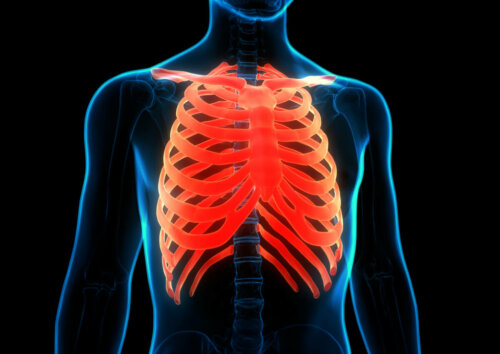Sports-Related Rib Injuries

Rib injuries can be severe, to the point where they may keep the athlete from doing sports for a while. The ribs are fine bones that no one usually pays much attention to. However, they’re responsible for protecting very important organs, such as the lungs and the heart.
Very strong trauma in the chest area can lead to dangerous internal damage, as it can perforate the pleura or affect some of the nerves that run in the intercostal spaces. Recovery is slow and requires strict rest. Keep reading this article to learn more!
The ribs – what are they like?
The ribs are bones that are part of the chest wall. First of all, they protect organs such as the heart and lungs. In addition to that, they take part in respiratory dynamics thanks to the intercostal muscles and the diaphragm.
Thanks to costal mobility and its capacity for expansion, it’s possible to increase the volume of air that enters when facing a demanding and somewhat complicated physical activity. Without it, it would be extremely difficult to increase the amount of oxygen to supply the metabolism of cells during aerobic exercises.
There are 24 ribs, each side of the thorax has 12 of them. They’re connected in the center by cartilage that reaches the sternum bone (that hard surface in the middle of the chest). The last two pairs of ribs are called floating since they don’t have that union with the rest. Although they’re smaller, they participate in the coverage of the upper pole of the kidneys.
There’s a space between the ribs that carries important structures. A bundle of arteries, veins, and nerves run between the intercostal muscles to supply and supply much of the body.
The most common sports-related rib injuries
As previously mentioned, there are two main sports-related rib injuries. One of them is a fracture, which can affect a single bone or several. On the other hand, there’s a contusion, which results in an inflammatory mixture between bone and muscle tissue.
Rib fractures
A rib fracture refers to the loss of bone continuity in these anatomical structures. The main cause is trauma caused by an external agent, such as a blow in boxing or a fall from a bicycle.
Many professionals in the medical community continue to discuss the difference between fissure and fracture. They’ve found that if someone has a fissure, it’s more than likely that they have a fracture as well since the bone has lost the continuity that joins one part with the other. For practical purposes, the treatment for both is practically the same.
This sports injury isn’t always punctual. It’s possible to find a burst fracture or multiple combined small breaks, increasing the risk of bone fragments going to the organs below. The complications that come from rib fractures can quite serious. Let’s see.

- Perforations. On certain occasions, the fractured rib pierces a large artery or the lung. When there’s an opening and tearing in the pleura, which is the layer that covers the lung tissue, the air that enters forms the clinical picture of pneumothorax. This, of course, constitutes a medical emergency.
- Tears. This is a major complication, especially from floating ribs. Its fractures into the body tear the liver or kidneys. Bleeding from these organs can be profuse and lead to peritonitis due to the accumulation of fluid within the abdominal cavity.
Rib contusion
If a sports injury fracture doesn’t occur to the rib, the trauma may lead to a contusion. In this case, the area becomes inflamed and bruised due to the rupture of arteries and veins. Because of it, the skin raises and is painful to the touch.
Furthermore, the skin goes through the evolutionary colors of hematomas, which indicates that it’s healing. At the same time, resting allows the injury to recover faster. It’s usual for the athlete to not be able to breathe properly in the beginning. It’s also difficult for them to move the upper limb on the affected side.
It takes a while to heal. In fact, the healing process tends to take a bit over a month just as long as the individual gets good rest and doesn’t make an excessive effort.
Moreover, the person may put on a tight bandage to speed up the process. Additionally, there are other things that may help with pain and healing. First off, applying cold temperature to the affected area. Secondly, taking pain relievers and anti-inflammatories (consult with a doctor first!).
When it comes to sports-related rib injuries, learning appropriate breathing techniques is a great thing to do. During physiotherapy sessions, the therapist teaches the athlete certain exercises that improve respiratory dynamics and help them overcome this functional limitation.

Good rest is an ally of rib injuries
Rest is essential in order to fully recover from rib injuries. Think about it: the lack of movement in the body facilitates healing and speeds up the process a lot. In any case, it’s necessary to consult a specialist in order to learn the extension of the damage.
For this, X-rays and computed tomographies are used. If necessary, the specialist will prescribe medication and physical therapy sessions to the patient. In brief, if you think you’ve suffered trauma during sports practice, don’t hesitate to consult with a doctor to obtain an accurate diagnosis.
Rib injuries can be severe, to the point where they may keep the athlete from doing sports for a while. The ribs are fine bones that no one usually pays much attention to. However, they’re responsible for protecting very important organs, such as the lungs and the heart.
Very strong trauma in the chest area can lead to dangerous internal damage, as it can perforate the pleura or affect some of the nerves that run in the intercostal spaces. Recovery is slow and requires strict rest. Keep reading this article to learn more!
The ribs – what are they like?
The ribs are bones that are part of the chest wall. First of all, they protect organs such as the heart and lungs. In addition to that, they take part in respiratory dynamics thanks to the intercostal muscles and the diaphragm.
Thanks to costal mobility and its capacity for expansion, it’s possible to increase the volume of air that enters when facing a demanding and somewhat complicated physical activity. Without it, it would be extremely difficult to increase the amount of oxygen to supply the metabolism of cells during aerobic exercises.
There are 24 ribs, each side of the thorax has 12 of them. They’re connected in the center by cartilage that reaches the sternum bone (that hard surface in the middle of the chest). The last two pairs of ribs are called floating since they don’t have that union with the rest. Although they’re smaller, they participate in the coverage of the upper pole of the kidneys.
There’s a space between the ribs that carries important structures. A bundle of arteries, veins, and nerves run between the intercostal muscles to supply and supply much of the body.
The most common sports-related rib injuries
As previously mentioned, there are two main sports-related rib injuries. One of them is a fracture, which can affect a single bone or several. On the other hand, there’s a contusion, which results in an inflammatory mixture between bone and muscle tissue.
Rib fractures
A rib fracture refers to the loss of bone continuity in these anatomical structures. The main cause is trauma caused by an external agent, such as a blow in boxing or a fall from a bicycle.
Many professionals in the medical community continue to discuss the difference between fissure and fracture. They’ve found that if someone has a fissure, it’s more than likely that they have a fracture as well since the bone has lost the continuity that joins one part with the other. For practical purposes, the treatment for both is practically the same.
This sports injury isn’t always punctual. It’s possible to find a burst fracture or multiple combined small breaks, increasing the risk of bone fragments going to the organs below. The complications that come from rib fractures can quite serious. Let’s see.

- Perforations. On certain occasions, the fractured rib pierces a large artery or the lung. When there’s an opening and tearing in the pleura, which is the layer that covers the lung tissue, the air that enters forms the clinical picture of pneumothorax. This, of course, constitutes a medical emergency.
- Tears. This is a major complication, especially from floating ribs. Its fractures into the body tear the liver or kidneys. Bleeding from these organs can be profuse and lead to peritonitis due to the accumulation of fluid within the abdominal cavity.
Rib contusion
If a sports injury fracture doesn’t occur to the rib, the trauma may lead to a contusion. In this case, the area becomes inflamed and bruised due to the rupture of arteries and veins. Because of it, the skin raises and is painful to the touch.
Furthermore, the skin goes through the evolutionary colors of hematomas, which indicates that it’s healing. At the same time, resting allows the injury to recover faster. It’s usual for the athlete to not be able to breathe properly in the beginning. It’s also difficult for them to move the upper limb on the affected side.
It takes a while to heal. In fact, the healing process tends to take a bit over a month just as long as the individual gets good rest and doesn’t make an excessive effort.
Moreover, the person may put on a tight bandage to speed up the process. Additionally, there are other things that may help with pain and healing. First off, applying cold temperature to the affected area. Secondly, taking pain relievers and anti-inflammatories (consult with a doctor first!).
When it comes to sports-related rib injuries, learning appropriate breathing techniques is a great thing to do. During physiotherapy sessions, the therapist teaches the athlete certain exercises that improve respiratory dynamics and help them overcome this functional limitation.

Good rest is an ally of rib injuries
Rest is essential in order to fully recover from rib injuries. Think about it: the lack of movement in the body facilitates healing and speeds up the process a lot. In any case, it’s necessary to consult a specialist in order to learn the extension of the damage.
For this, X-rays and computed tomographies are used. If necessary, the specialist will prescribe medication and physical therapy sessions to the patient. In brief, if you think you’ve suffered trauma during sports practice, don’t hesitate to consult with a doctor to obtain an accurate diagnosis.
All cited sources were thoroughly reviewed by our team to ensure their quality, reliability, currency, and validity. The bibliography of this article was considered reliable and of academic or scientific accuracy.
- Pappa, Ana Christina Castillo. NEUMOTÓRAX SECUNDARIO A FRACTURAS COSTALES. Diss. Universidad de San Carlos de Guatemala, 2018.
- Matamoros, Sibaja, and A. Dáuber. “Trauma de tórax: fisiopatología y manejo del tórax inestable con contusión pulmonar.” Revista Médica de Costa Rica y Centroamérica 72.617 (2016): 687-693.
- Lora Veramendi, Maylin. “Tratamiento fisioterapéutico en fractura de esternón y costillas.” (2018).
- Puyol, Sonia Galicia, et al. “TIPOS DE FRACTURAS COSTALES ENCONTRADAS EN TRAUMATISMOS COSTALES.” Seram (2018).
- Velásquez, Mauricio, and Viviana Orozco-Martín. “Manejo quirúrgico de las fracturas costales: experiencia en un centro de referencia.” Revista Colombiana de Neumología 28.2 (2016): 72-77.
- Fernández, Liliana. “Manejo quirúrgico de las fracturas costales.” Revista Colombiana de Neumología 28.2 (2016): 61.
This text is provided for informational purposes only and does not replace consultation with a professional. If in doubt, consult your specialist.








